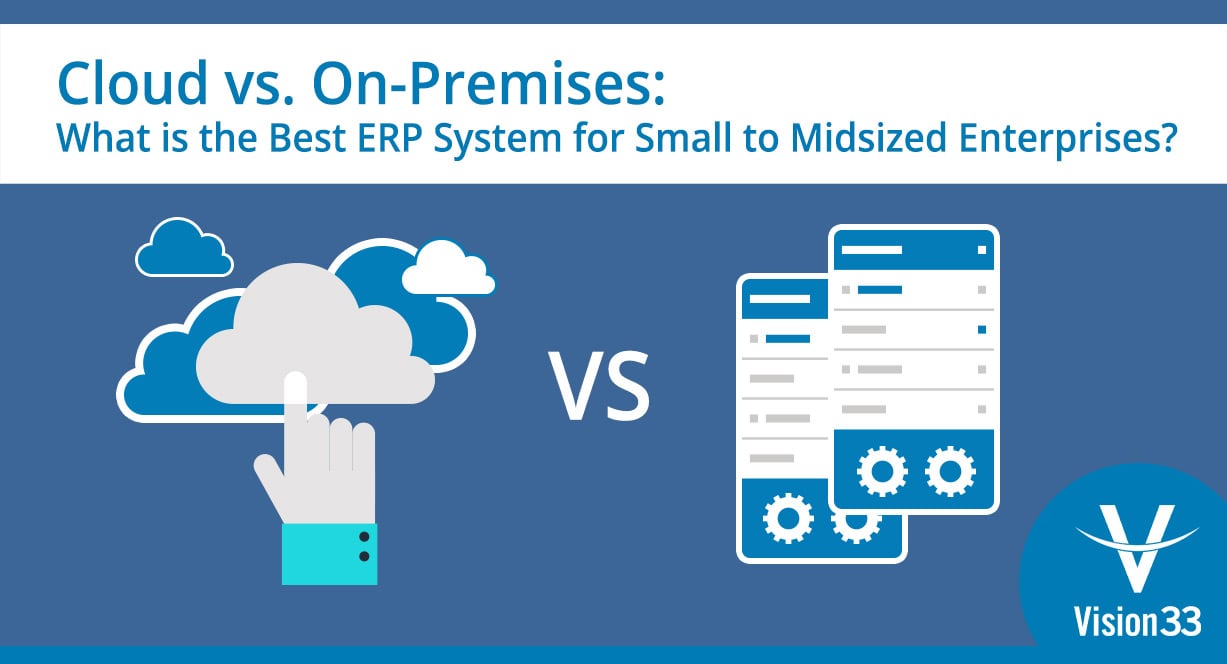When considering an Enterprise Resource Planning (ERP) solution for a small to midsized enterprise (SME), an important consideration is which deployment method to choose for your system: On-premise or in the cloud. Read the latest Vision33 article to find out what's right for your growing business.

When considering an Enterprise Resource Planning (ERP) solution for a small to midsized enterprise (SME), an important consideration is which deployment method to choose for your system. Will you choose a cloud-based ERP solution or one that’s installed on-premise? How you deploy your new ERP solution will impact your staff, resources, budget and in the long run, your bottom line. But how is cloud? A quick Google search reveals that there are a lot of definitions out there. When people talk about the cloud are they even talking about the same thing? Read on to find out what the cloud is, and why business chose one method and ERP solution over another for their next ERP deployment.
Cloudy Terminology
Deploying your ERP solution in the Cloud means your company’s ERP solution and its associated data will be managed centrally by an ERP solution vendor and accessed via a web browser. When you choose on-premise, your ERP solution is installed locally on your company’s hardware and servers and is managed by your IT staff. But such definitions leave out an understanding of the value this cloud-based technology offers SMEs; it’s important not to get caught up in thinking that cloud is about place.
At last year’s SAPPHIRE NOW (financial systems leader SAP’s annual conference) Michael Dell said that the “cloud is not a place, it’s a way of doing IT.” This definition does a great job of defining the cloud’s purpose. It comes down to how do you want to manage the information technology, the hardware, the networks, cables – all of that – needed to support the implementation of an ERP system, your business’ backend.
Which is the Best Cloud ERP software?
There’s no simple answer to what the best Cloud ERP software on the market is. In some cases, ERP solution providers will make a distinction between a “true” cloud solution versus one that is hosted. However, it’s important to note that this distinction is not deciding factor for SMEs. Regardless of how you define a cloud ERP, what we’re talking about is ERP that gives users the flexibility to obtain subscription-based pricing and the ability to outsource the software and hardware management of an ERP system. For a dissemination on Software as a service (SaaS) read our recent article How Growing SMEs Can Afford World-Class ERP Solutions on a Tight Budget.
A leading ERP solution, like SAP Business One, offers business the best of both worlds and can be deployed either on-premise or in the cloud. In either scenario, it is possible to integrate core business functions across your entire company, from financials and accounting, to inventory and production.
Both options have their merit so before you decide what method will best fit your business, you need to consider factors like your infrastructure, IT support, required hardware, time frame for implementation, your anticipated benefits, and most importantly - costs.
Cloud Cost Savings
When considering the costs associated with deployment method, consider first the main cost areas associated with ERP are. It’s really a question of infrastructure. Here’s a few of the key cost centres that will vary depending on your decision to go the on-premise, or cloud deployment route.
- Reliability of the System: What happens if the system servers go down? What impact will that have on your operations’ essential services and who will be responsible to ensure it’s up and running?
- Capital Investment: Does your business have the financial resources to afford the investment and subsequent the company-wide hardware refresh cycles every four or five years?
- Operations Expenses: How much are your operating expenses with this method of deployment.
- Provisioning Time: How long will the method of deployment add to implementation? Do you have a time constraint, like a market expansion, product launch, or acquisition that will impact your time line for the implementation of your next ERP?
- Flexibility: Can you easily upgrade your ERP solution to support the software and systems needed to respond to market opportunities, or open a new branch, or support a new area of business like light production, or manufacturing?
- Staff Expertise: Do you have the IT resources that know how to administer the system, and handle system upgrades?
Rationalising why your business would want to incur all the costs associated with having their own application infrastructure can help in choosing which deployment option you chose for your next ERP solution. At Vision33, we believe in the promise of technology to deliver SMEs innovative solutions. Other factors to consider when compared to traditional ERP on-premise implementations are the benefits of this innovative technology.
The Benefits of the Cloud Lie in Innovation
Over the last decade, Vision33 has seen more and more SMEs turn to cloud deployment for numerous reasons. For many SMEs, the Cloud can help them stay current with the latest technology, putting them ahead of the competitors who stick to old ways of doing business. When someone else is managing your IT, you can keep the focus on achieving your business goals.
Faster Deployment
Need a new ERP solution fast? Cloud can enable SMEs to reach full deployment in weeks, and with a mobile-grade user experience, you can shave off the time and money associated with user training for your business.
More Frequent Innovation Updates
Multiple innovation release per year mean, your business benefits from the rapid development of new features requested by other cloud ERP users.
Agile Deployment Configuration and Integration
Rapid process configuration, faster adoption of technology, much shorter upgrade cycles, and packaged integration.
Lower Capital Expenditure and Faster Time to Value
Lower initial solution and fees, no maintenance, and lower upgrade costs mean a lower total cost of ownership.
So, Which Deployment Option Should I Choose?
Return on Investment (ROI) calculators typically define the payback of investments against the benefits to the business using financial terms and variables that are static. These calculations fall short when used in the more complex, constantly evolving world of cloud computing. Deployment models vary and options change frequently - this can break traditional ROI models, leaving potential benefits unaccounted for.
It’s easier to set the right metrics for calculating the ROI of a subscription-based service (SaaS), for example, than it is to determine the right metrics for an enterprise-wide administrative system (e.g. hosted ERP). The service’s cost is relatively fixed with value measured against the number of users, whereas the value of an administrative system is spread in nuanced ways institution-wide. Simply put, benefits extend beyond IT, changing the way functional areas conduct and approach business.
To help you further narrow down your choice Vision33 has a helpful ERP deployment guide that nicely summarises the differences and additional considerations.


